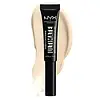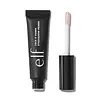NYX Cosmetics Ultimate Shadow & Liner Eye Primer Versus e.l.f. cosmetics Lock It Down Eyeshadow Primer
What's inside
What's inside
 Key Ingredients
Key Ingredients

 Benefits
Benefits

No benefits
 Concerns
Concerns

 Ingredients Side-by-side
Ingredients Side-by-side

Isododecane
EmollientTrimethylsiloxysilicate
EmollientMica
Cosmetic ColorantIsohexadecane
EmollientDimethicone
EmollientVp/Hexadecene Copolymer
Silica Dimethyl Silylate
EmollientPhenyl Trimethicone
Skin ConditioningPolyglyceryl-3 Diisostearate
EmulsifyingPolyethylene
AbrasiveTriethyl Citrate
MaskingCaprylyl Glycol
EmollientDisteardimonium Hectorite
StabilisingEthylhexylglycerin
Skin ConditioningTocopheryl Acetate
AntioxidantPentaerythrityl Tetra-Di-T-Butyl Hydroxyhydrocinnamate
AntioxidantSorbic Acid
PreservativePhenoxyethanol
PreservativeCI 77491
Cosmetic ColorantCI 77492
Cosmetic ColorantCI 77499
Cosmetic ColorantIsododecane, Trimethylsiloxysilicate, Mica, Isohexadecane, Dimethicone, Vp/Hexadecene Copolymer, Silica Dimethyl Silylate, Phenyl Trimethicone, Polyglyceryl-3 Diisostearate, Polyethylene, Triethyl Citrate, Caprylyl Glycol, Disteardimonium Hectorite, Ethylhexylglycerin, Tocopheryl Acetate, Pentaerythrityl Tetra-Di-T-Butyl Hydroxyhydrocinnamate, Sorbic Acid, Phenoxyethanol, CI 77491, CI 77492, CI 77499
Isododecane
EmollientTrimethylsiloxysilicate
EmollientMica
Cosmetic ColorantHydroxystearic/Linolenic/Linoleic Polyglycerides
EmollientDimethicone
EmollientSynthetic Wax
AbrasiveDisteardimonium Hectorite
StabilisingTriethylhexanoin
MaskingTrihydroxystearin
Skin ConditioningSorbitan Sesquioleate
EmulsifyingVp/Eicosene Copolymer
C18-38 Alkyl Hydroxystearoyl Stearate
EmollientPropylene Carbonate
SolventEthylhexylglycerin
Skin ConditioningTriethoxycaprylylsilane
Tocopherol
AntioxidantCI 77891
Cosmetic ColorantCI 77492
Cosmetic ColorantCI 77491
Cosmetic ColorantIsododecane, Trimethylsiloxysilicate, Mica, Hydroxystearic/Linolenic/Linoleic Polyglycerides, Dimethicone, Synthetic Wax, Disteardimonium Hectorite, Triethylhexanoin, Trihydroxystearin, Sorbitan Sesquioleate, Vp/Eicosene Copolymer, C18-38 Alkyl Hydroxystearoyl Stearate, Propylene Carbonate, Ethylhexylglycerin, Triethoxycaprylylsilane, Tocopherol, CI 77891, CI 77492, CI 77491
Ingredients Explained
These ingredients are found in both products.
Ingredients higher up in an ingredient list are typically present in a larger amount.
Ci 77491 is also hydrated iron III oxide. It's sole purpose is to give a red/pink hue to products.
Iron III oxides are classified as inorganic chemicals for coloring.
Synthetically created Ci 77491 is considered safer than those naturally found. This is because the synthetically created version may contain less impurities. Iron oxides are generally non-toxic and non-allergenic.
Learn more about CI 77491Ci 77492 is also hydrated iron III oxide. It's sole purpose is to give a yellow hue to products.
Iron III oxides are classified as inorganic chemicals for coloring.
Synthetically created Ci 77492 is considered safer than those naturally found. This is because the synthetically created version may contain less impurities. Iron oxides are generally non-toxic and non-allergenic.
Learn more about CI 77492Dimethicone is a type of synthetic silicone created from natural materials such as quartz.
What it does:
Dimethicone comes in different viscosities:
Depending on the viscosity, dimethicone has different properties.
Ingredients lists don't always show which type is used, so we recommend reaching out to the brand if you have questions about the viscosity.
This ingredient is unlikely to cause irritation because it does not get absorbed into skin. However, people with silicone allergies should be careful about using this ingredient.
Note: Dimethicone may contribute to pilling. This is because it is not oil or water soluble, so pilling may occur when layered with products. When mixed with heavy oils in a formula, the outcome is also quite greasy.
Learn more about DimethiconeDisteardimonium Hectorite comes from the clay mineral named hectorite. It is used to add thickness to a product.
It can also help stabilize a product by helping to disperse other ingredients.
Hectorite is a rare, white clay mineral.
Learn more about Disteardimonium HectoriteEthylhexylglycerin (we can't pronounce this either) is commonly used as a preservative and skin softener. It is derived from glyceryl.
You might see Ethylhexylglycerin often paired with other preservatives such as phenoxyethanol. Ethylhexylglycerin has been found to increase the effectiveness of these other preservatives.
Isododecane is a fragrance, emollient, and solvent.
As an emollient, it helps your skin stay soft and hydrated. Emollients help trap moisture into your skin.
Isododecane's role as a solvent makes it a great texture enhancer. It spreads smoothly on skin and does not leave a sticky feeling behind. Isododecane also helps prevent color transfer in makeup products.
Isododecane is not absorbed into skin.
Learn more about IsododecaneMica is a naturally occurring mineral used to add shimmer and color in cosmetics. It can also help improve the texture of a product or give it an opaque, white/silver color.
Serecite is the name for very fine but ragged grains of mica.
This ingredient is often coated with metal oxides like titanium dioxide. Trace amounts of heavy metals may be found in mica, but these metals are not harmful in our personal products.
Mica has been used since prehistoric times throughout the world. Ancient Egyptian, Indian, Greek, Roman, Aztec, and Chinese civilizations have used mica.
Learn more about MicaThis silicone is an emollient. Emollients create a thin film on the skin to prevent moisture from escaping.
It is not soluble in water and helps increase water-resistance in products.
According to a manufacturer, it can blend seamlessly with silicone oils, such as Cyclopentasiloxane.
Learn more about Trimethylsiloxysilicate